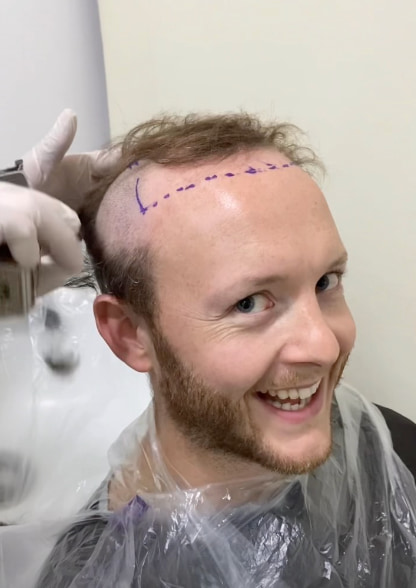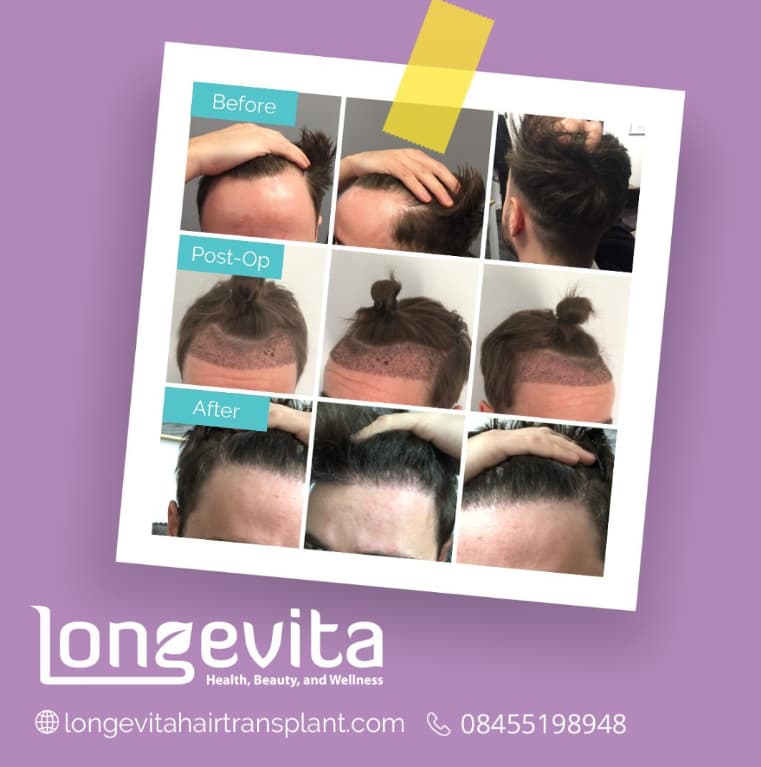Many people are unwilling to undergo a hair transplant because they don’t want to shave their hair. This is why many clinics now offer unshaven hair transplants. This, however, is a misnomer since even unshaven hair transplants require shaven donor areas (partially or completely).
But there is a truly no-shave-required variety of hair transplant that’s available out there. It’s called long hair transplant or long hair FUE. And it’s exactly how it sounds. It promises discretion and a preview of the final results right away. But it has more than a few problems that make it less desirable than traditional FUE hair transplants.
What Is Long Hair FUE?
Long hair follicular unit extraction (FUE) is a transplantation technique in which patients can keep the original length of their hair in the donor and recipient areas. There is no need for shaving or trimming the hair, even if your hair is inches long.
Hair is usually trimmed to 1-2 mm in a traditional FUE procedure so the punch tool can be positioned accurately and the grafts can be removed without damage. A long hair transplant, however, keeps the entire length of the hair and relocates it along with the follicle.

Through this, patients are able to hide the punch wounds in the donor area and incisions in the surgical area. The long hair camouflages those areas.
Another benefit of this technique is that the patients are able to visualise their results immediately after the surgery (it can vary since results depend on the number of hair grafts that eventually survive – called the yield). There are some other pros of long hair transplant, such as:
- It reduces the risk of overharvesting as the surgeon can preview the density of the donor area.
- Allows the surgeon to see the angle at which the hair curves so the follicle can be placed in the right direction.
For these reasons, long hair FUE is often called “state-of-the-art” or the “latest” and “most advanced” hair transplant technique. However, this is only half the picture. This technique has some very significant drawbacks.
What Is The Procedure For Long Hair Transplant?
You’ll first be given local anaesthesia so that you don’t feel any pain during the surgery. After that, the surgeon will begin by scoring the grafts in the donor area. This is the most challenging and time-consuming part of this surgical technique.
Your surgeon might begin by segmenting the donor area. As patients are typically sitting, their hair is clipped back up with small clips. This exposes a small section of the scalp (less than 1 cm wide), and from this, the surgeon begins to score the grafts using a handheld or motorised punch tool.
It is not possible for the surgeon to do this alone. For instance, a surgical assistant actually extracts the grafts that have been scored by the surgeon. This step alone can take about 3 hours (more if more grafts are needed).
Following that, the grafts are stored and sorted, and the surgeon makes incisions in the recipient area. The hair grafts are then implanted in another 2 or more hours. Keep in mind that a traditional FUE can take 6-8 hours, so this will take even longer. And during the graft extraction process, you’ll be sitting with your head angled down. This can be quite uncomfortable.
What Are The Drawbacks of Long Hair FUE?
While you can get a hair transplant with long hair, it has certain disadvantages, which are as follows:
Damage To Hair Grafts
In the traditional FUE hair transplant, the donor area is shaved so that the surgeon can clearly see the hair graft, position the very small opening of the punch tool around it and score the tissue. If the graft isn’t clearly visible, the surgeon might not angle the punch tool correctly. As a result, they may end up scoring through the hair follicle, which will permanently damage it.
The same can happen if the depth of extraction is not right. The risk of this happening is quite high in long hair FUE. In general, the hair follicle transection rate (when the hair bulb is damaged) is twice as high in long hair transplants compared to the traditional FUE. And this can make a significant difference if the patient doesn’t have enough hair in their donor area.
The problem is visibility. The grafts in the donor area are not clearly visible to the surgeon because of the long hair. Not just that, but when the surgeon extracts grafts, the blood-matted hair can create further problems.
Low Hair Density
If the patient’s donor area is limited and too many of the hair grafts are damaged, it will result in poor hair density. Keep in mind that it’s not really the number of grafts that matters but their yield or how many survive.
Even if the hair density looks good immediately after the surgery, you may eventually lose density due to damaged hair follicles. You need to be especially careful about this if you already don’t have enough hair in the donor area. If the surgeon doesn’t have enough experience performing this surgery, they can very easily botch it.
Risk Of Graft Dislodgement
A lot of people who undergo long hair transplants are preparing for a major event shortly afterward. So, you can’t expect them to not style, comb, or even touch their hair in any way. The only problem with this is that it can dislodge the grafts on their scalp.
Another downside of having long hair during recovery is that if sweat accumulates, it increases the risk of infection. All this will also result in poor hair density.

Even patients who undergo unshaven hair transplant tie their hair up for 10 days after the surgery so that they don’t end up dislodging their grafts accidentally. That’s because having long, untied hair can mess with the newly transplanted grafts.
Multiple Sessions Needed
The maximum number of grafts extracted and transplanted in a long hair transplant is 2,000-2,500 per day. Usually, it’s around 1,500 or even less. That’s because extracting long hair alone can take quite a while. So, the surgeon cannot extract too many grafts in just 1 day. The surgery would simply take too long, which is not feasible.
If the patient’s balding area is large and they need more than 2,500 grafts, they’ll most likely have to get multiple sessions of this surgery. And this can be quite inconvenient and costly.
Costs More
Considering that long hair transplants are more complicated and time-consuming, they are more expensive than traditional FUE. A bigger team is needed to perform this surgery. Additionally, it requires special tools.
For instance, the punch tool is designed so that it can accommodate long hair. Instead of rotating, it oscillates so that the shaft of the hair does not wrap around the follicle. For this reason, you can expect to pay more for a long hair transplant.
Keep in mind that prices can vary depending on the number of grafts you need and the surgical technique (traditional FUE or DHI). The location of the clinic will further impact the cost.
And lastly, you should know that surgeons who perform long hair transplants need to be very experienced. Otherwise, the surgery won’t be a success. And the surgeon’s expertise will determine the overall cost of your medical travel plan.
Doesn’t Prevent Shock Loss
This is one of the important things to consider before having a long hair FUE. Even if you’ll have long hair immediately after the surgery, you’ll eventually lose it to temporary shock loss. Having long hair FUE won’t prevent it from happening.
Your transplanted hair will fall 2-3 weeks after the surgery, and your hair won’t start growing until after 3 months. So, you’ll also see the final results of your procedure after 12-18 months. So, you have to decide whether it’s worth spending extra to see your hair transplant results immediately for just 1 week or so.
Alternatives To Long Hair Transplant
There are different options for shaving or trimming the head when it comes to hair transplants. You don’t always have to shave your entire head. A patient has the following options:
- Leave the recipient area unshaven and shave the entire donor area (like a crew cut)
- Leave the recipient area unshaven and shave a section or multiple sections of the donor area; it’ll be camouflaged by long hair.
Here, you should know that partial shaving is only possible if the patient needs very few hair grafts. The bigger the size of the balding area, the more grafts you’ll need from the donor area. And those areas are better shaved.
Conclusion
It is understandable that people are uncomfortable with the scrutiny associated with hair transplants. However, you have to keep in mind that it’s just short-term pain for long-term gain. While long hair transplants are tempting in theory, there are many problems with them. One of the biggest reasons why you should avoid it is that it can give you poor results.
What you see immediately after the surgery will not be the final result. You will lose hair to shock loss after a couple of weeks, and you’ll only see the results after 1-1.5 years. During that time, there’s a greater risk of damage to the grafts if your hair is not shaved or trimmed. If you’re still considering this surgery, make sure to discuss its pros and cons with your surgeon (who needs to be very experienced).


